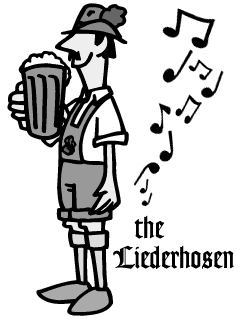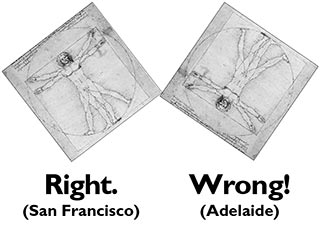| | 
- 28 June 2000
- The Liederhosen Restaurant
- San Francisco has around four thousand restaurants open on any given day, with hundreds of such businesses opening and going out of business every year. Given that the region is home to people from many cultures, it’s just a matter of time until just about every cuisine possibility appears on some menu.
And so it was that Jenny took me to dinner at “the Liederhosen,” an Austrian-Mexican restaurant. The place was packed, in large part due to a small typographical error. The proprietors doubtlessly intended to name their restaurant “the Lederhosen,” or “leather pants.” By adding an extra letter, though, they inadvertently named their establishment “singing pants.” This typographical error, combined with the caricature of the Tyrollean beer drinker, proved to be most amusing to San Francisco’s cognoscenti, many of whom dined at the Liederhosen just to grab a handful of matchbooks. When Jenny and I went there, the owners were selling a huge selection of Liederhosen merchandise, including mugs, t-shirts, and posters. (As for the food, I quite enjoyed the forelle burrito, but I cannot recommend the schnapps margarita under any circumstances.) 
- 29 June 2000
- Crossing the Equator, Safely
- I’ve been on a number of dangerous trips in my life, but none so scary as today’s flight from San Francisco to Adelaide via Sydney. This was the first time I’ve ever been south of the equator, and I was dreading the barbaric hazing ritual that experienced travelers customarily inflict on anyone crossing the north/south divide for the first time.
To be specific, I feared that rowdy crew members would pull down my pants and paint my bits blue when we crossed into the southern hemisphere. I hear that this rite of passage—or worse!—is suffered by all too many people when they first cross the equator. As has happened so many times, beer provided a solution to my dire predicament. Soon after takeoff, I asked a flight attendant what beers were available. She said, “Budweiser (she was of course referring to the American beer-flavored water speciously marketed as real beer, not the authentic Czech brew), Miller,” and then she said something like “PG” or “CP” or some other two-syllable acronym. She repeated it twice, but I still couldn’t understand what she was saying. “DZ?” “T three?” Finally, she explained that she was offering Victoria Bitter, or VB. “Oh, VB!” I replied. “I’ll have two, please.” After that, every time a flight attendant came within hearing range, I shouted “VB!” VB wasn’t bad for airline beer, not bad at all. After a while, the shiftless crew members avoided coming anywhere near me. The indolent servants ignored me, even when I waved two fingers in the air, yelled “VBs! Yoo-hoo! VBs! VBs!” My clever strategy worked. By the time we reached the equator, none of the airline’s employees would come within five meters of me. My first crossing of the equator passed eventfully. 

- 30 June 2000
- Down, Down Under
- I’m not really enjoying my first day in the southern hemisphere. Everything here in Adelaide is wrong: wrong wrong wrong!
The natives spell funny and drive on the wrong side of the road, but those are rather petty problems with which I’m familiar. There are other complications, too, such as the water swirling down the drain in the wrong direction. This phenomenon has a digital counterpart. I can’t connect to my Internet server in San Francisco because the reverse data spirals collide with the standard packets somewhere over (under?) the Pacific Ocean. Or something like that. My technical consultants advise me I need a counterspiral coprocessor for my computer. Fixing my machine is just a matter of money; that’s the least of my worries. It seems that I am upside down; I can’t seem to keep beer in my glass for very long. (Although that’s a familiar condition, this is the first time that gravity has been part of the missing beer equation.) And to make upside down matters worse, the blood keeps rushing to my head. This, combined with the lessened gravitational pull because of the southern hemisphere’s greater centrifugal force, makes me lightheaded. It’s difficult to walk. I consulted my reference volumes, and discovered precisely the severity of the situation. San Francisco is 37°48' north of the equator. Adelaide is 34° 52' south of the equator. These numbers really don’t tell the whole story, but Leonardo da Vinci’s Vitruvian Man does. Vitruvius’s lad can get by just fine in San Francisco. He need only adjust an arm here and a leg there to keep his beer in his glass and a comfortable balance. To use popular Australian slang, “no worries.” But when our man gets to Adelaide, he flails around, upside down, like a moth impaled on a collector’s pin. I can now understand why the Brits set this island up as a penal colony. What I can’t understand, though, is why so many people stayed. 
- 1 July 2000
- Not Going Native
- The British aren’t as stupid as some people claim. After all, they sent their loony religious zealots to North America and their most incorrigible criminals to Australia. Pip pip, cheerio, and good riddance!
The fanatics and crooks took the same approach to the native people. In Australia, that meant “appropriating” their land and doing the best they could to eliminate the Aborigines and their culture. Fortunately, the cretin conquerors failed. After spending all of twenty-four hours in Australia, I’ve seen lots of evidence of a proud Aboriginal culture. Before today, everything I knew about Aboriginal life could be summed up in two words: “boomerang,” and “didjeridu.” Today, the only thing I’ve learned is how much I don’t know. I always thought of the boomerang as a hunting weapon, but after seeing a video in an Adelaide museum, I now realize it’s a very versatile tool. For example, when used as a lever it’s remarkably effective in separating a dead kangaroo’s tendon from the bone. And as for the didjeridu, I discovered that the good musicians use “circular breathing”—simultaneously inhaling and exhaling—when playing that exceptional instrument. I also found out that the didjeridu is made from a eucalyptus branch (hollowed out by helpful termites) with a beeswax mouthpiece. (That’s the horrible side-effect I suffer from going to museums: I walk away talking like a fourth-grade teacher.) I’m embarrassed to admit that I have a hard time thinking of didjeridus as musical instruments, since in my culture they’re usually associated with would-be hippies, hippies, and hippies emeritus. I fear it will take at least two or three generations before westerners can see the didjeridu for the remarkable creation it is. I’m tempted to buy a didjeridu and take it back to San Francisco. Dressed in tie-dye clothing, a headband, sandals, and drenched in patchouli oil, I could cut a swath of terrible destruction through the city’s financial district. Although I like the idea of terrorizing some life back into the poor office drones, a didjeridu in the wrong hands, i.e., mine, is something that’s too horrible to contemplate seriously. 

- 2 July 2000
- Postapocalypse Now
- I saw a most unusual sight as I was strolling down the pedestrian mall in central Adelaide: I saw a truck. And just not any truck, either. The vehicle in question wasn’t a delivery truck or someone’s personal transportation, it was one of those huge, gigantic freighters, a semi. An American might have called it an eighteen wheeler, except that it wasn’t pulling a long eight-wheel trailer, or anything else for that matter.
It turns out that this was no ordinary monster truck. The chrome-plated ornately-painted monstrosity was a racing truck. I couldn’t imagine how such a behemoth could race, all I could think about were sumo wrestlers jogging. As it turned out I didn’t have to use my imagination. Right now, I’m watching the “Super Trucks” racing on my hotel television. I feel like I’m finally seeing the real Australia. At last! (I’m sure there’s more to contemporary Australian Caucasian culture than internal combustion engines; it’s just that I haven’t seen it yet.) The mammoth trucks lumbering around the race course do in fact remind me of sumo wrestlers; they’re huffing and puffing through narrow paths, slamming into each other with reckless—but not wreckless—abandon. I’m fascinated by the subtle nuances of Super Truck racing. For example, the racers seem to use the trucks’ great clouds of dense diesel smoke to strategic advantage by temporarily blinding the drivers behind them. I’ve never seen that strategy employed by even the best of the Formula One pilots! Years ago, I remember watching a movie about a postapocalyptic Australia in which barbaric tribes of motorized maniacs dominated the continent. Since I was somewhat confused at the time, I’m now wondering if the film was a documentary. 
- 3 July 2000
- The Theory of Attractive Relativity
- I headed off to dinner tonight with four friends: Katherine, Sigi, Dave, and Frederick of Monaco. It was a chilly night, and I ended up walking arm-in-arm with Katherine and Sigi, with Dave and Frederick of Monaco walking behind us. Those European women are so sophisticated! Especially when surrounded by Australians, the Texans of the South Pacific.
Later, Dave took me aside at the restaurant to give me some friendly advice. Specifically, he advised me that I had “screwed up big time” walking down the street with our female colleagues. “What are you talking about?” I protested. “It was entirely innocent.” “I wasn’t talking about the appearance of hanky-panky,” Dave explained; “they’re not the canoodling type. I was talking about appearances in general.” “I don’t get it,” I said. “What do you mean by general appearances?” “Well, Katherine and Sigi are attractive women, no?” he asked. “What’s that got to do with anything?” I replied. “Well, it’s just that you’re, well, not the most handsome guy,” he said diplomatically. “You get by OK, but when you walk down a public street with an attractive woman on either side, it really draws attention to the fact that you’re, um, not so attractive, relatively speaking.” He was, of course, right, so I thanked him for his observation. When we went to a bar, a made a point of joining Frederick of Monaco in conversation with a couple of drunken Australian rugby players. Later, Dave congratulated me on my choice of drinking companions. As he put it, “You’ll always look good when you’re surrounded by guys who have no necks.” 
- 4 July 2000
- No Jaywalking Worries
- Jaywalking is the safest way for pedestrians to survive in a city full of reckless drivers. Although I don’t have any evidence to support my theory, I suspect that a large percentage of people hit by cars were probably watching traffic signals, not the traffic. I routinely see people begin to cross the street the moment the signal turns green, without first looking for cars speeding through a red light.
I find it best to ignore the traffic lights and concentrate on the cars. This technique served me well in Australia, although there were some initial complications. Apparently, I inadvertently offended some of the Australian drivers with my scofflaw behavior. They expressed their disapproval by speeding up and trying to hit me. It didn’t take me long to figure out that most of them were bluffing. Since automobiles these days have such flimsy bumpers, even slamming into eighty kilograms of meat can disable a new car. I soon learned to ignore most of the aggressive motorists. I also figured out how to identify the vehicles that posed a real threat. Australia is so full of kangaroos that the big marsupials represent a traffic hazard. As a result, perhaps five percent of Australian vehicles have mammoth bumpers designed to absorb the impact of colliding with a kangaroo, or any other animal on the road, such as a jaywalker. After I learned to differentiate between the nine-five percent of the traffic that posed no threat and the five percent of vehicles that could blast through any animal in their path, jaywalking in Australia proved to be easier than any other country I’ve visited. No worries! 
- 5 July 2000
- OK Curry
- Craig went shopping for Australian souvenirs, and spotted a teddy koala bear (koala teddy bear?). Craig asked a clerk what material was used to make the toy’s fur. This query led to a call to the supervisor, who informed Craig that the koala’s fur was, in fact, kangaroo fur.
Craig then asked if the store carried stuffed kangaroos covered in koala fur. The manager of the store asked Craig to “kindly leave the store.” The Australians certainly are an inscrutable people! Who can explain the different fortunes of the kangaroo and the koala? Certainly not me. They’re both handsome creatures, and each has a certain anthropomorphic appeal. Yet the koala is regarded as cute and cuddly, whereas the kangaroo is regarded as a pest. I read that Australians kill some three million kangaroos annually. I’m not sure what percentage are road kill and what number are shot, but that’s a lot of kangaroos. I thought I was going to leave Australia without ever seeing a kangaroo, but one was hiding in my curry. (I thought “OK Curry” meant “OK for vegetarians,” but it turned out to be full of Ostriches and Kangaroos.) 
last transition | index | next transition
©2000 David Glenn Rinehart
| |

